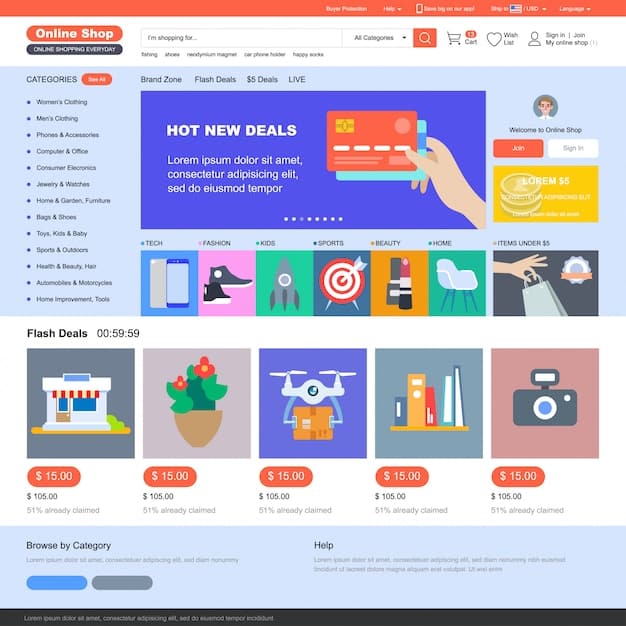Boost US Conversions: Advanced E-commerce Platform Customization

E-commerce platform customization involves employing advanced techniques to tailor the online shopping experience to user preferences, ultimately aiming to increase conversion rates by 10% through personalization, optimized user interfaces, and seamless mobile experiences within the US market.
Ready to transform your e-commerce platform and see a significant boost in your US conversion rates? E-commerce platform customization: 3 advanced techniques to increase US conversion rates by 10% is within reach, by focusing on personalized experiences and streamlined user interfaces.
Unlocking Growth: The Power of E-commerce Platform Customization
E-commerce is a dynamic playing field where adaptation means survival. Rather than relying on a one size fits all method, customized platforms offer an individualized user experience that may improve conversion rates substantially. Let’s dive into why customization is crucial for e-commerce success.
Customization goes beyond aesthetics; it’s about crafting an environment that resonates with your target audience, improving their customer journey, and delivering an unmatched buying experience. It enables you to showcase products more successfully, simplify the checkout for higher sales, and cater to mobile consumers’ increasing needs through responsive design and a rapid load time.

Technique 1: Advanced Personalization Tactics
Personalization is a game-changer. By tailoring the customer journey to individual preferences, you can significantly enhance engagement and drive conversions. But how do you move beyond basic personalization?
Data-Driven Product Recommendations
Traditional recommendation engines often rely on simple algorithms. Advanced personalization uses machine learning to analyze browsing history, purchase patterns, demographic data, and even real-time behavior in order to deliver suggestions which are very relevant. This makes certain customers view material and offers tailored specifically for them.
Dynamic Content Based on User Behavior
Imagine web pages that could change depending on the user’s activities. If a person views a certain category a few times, the site will automatically push related goods to the top. This dynamic content displays that you are aware of the user’s needs which enhances their experience and their chance of conversion.
- Implement machine learning algorithms: To analyze customer data and predict preferences.
- Integrate real-time behavioral tracking: To adapt content to current user actions.
- Use personalized email marketing: To re-engage customers with tailored product suggestions.
- Test different personalization strategies: A/B testing gives you insights to optimize your tactics.
Advanced personalization tactics go far beyond simple recommendations. They involve understanding your customers on a deeper level and using that knowledge to create a truly unique and engaging shopping experience, thus driving increased conversion rates.
Technique 2: Optimizing the User Interface (UI)
The interface is important to how people interact with your site; therefore, upgrading it may greatly improve usability and conversions. Let us examine measures designed to streamline the layout and boost the ease of use of your website.
Streamlined Navigation and Search Functionality
Clients ought to be able to navigate your website without difficulty. Employing intuitive navigation, like drop down menus and categorized filters, can simplify the process of locating the ideal product. An improved search function will rapidly return relevant results by using features, such as autocomplete and mistake tolerance; this improves user satisfaction and also reduces abandonment.
Mobile-First Indexing and Responsive Design
Because the bigger part of web traffic originates from mobile devices, it is imperative to take a “mobile first” strategy. Responsive design makes sure your website adjusts flawlessly to varied screen sizes, offering a continuous experience on smartphones, tablets and desktop devices. Maximize your mobile website regarding speed and simplicity in order to decrease bounce rates particularly amongst mobile users.

- Conduct user testing: Acquire insights into user behavior for identifying points to improve usability.
- Simplify checkout: Decrease the number of steps and fields that need completing to make it a more efficient process.
- Optimize UX writing: Employ descriptive labels and concise direction regarding products when creating a better understanding.
- Prioritize accessibility: Be sure the website conforms with accessibility directives to ensure that every person can use it.
By focusing on a streamlined navigation, prioritizing mobile-first indexing, and consistently optimizing based on user feedback, you can create a user interface that not only looks great but also converts visitors into loyal customers, ultimately boosting your conversion rates.
Technique 3: Leveraging Social Proof and Trust Signals
Trust creates confidence and security in the minds of customers; utilizing social proof will significantly affect conversion rates. You ought to utilize evaluations, evaluations, and certification to guarantee that new clients feel secure in deciding to work with your own platform.
Displaying Customer Reviews and Ratings Prominently
Displaying customer reviews and ratings prominently can boost credibility and confidence. Positive feedback and comments provide a social validation seal. Making it easier for potential buyers to make informed decision, especially when the reviews are genuine and varied.
Integrating Security Badges and Trust Seals
Security badges, certificates from well known third parties, and trust seals guarantee buyers that the transactions are safe from their website. They represent a protected environment and secure payments which makes consumers very certain while deciding whether or not your website is the right place to do business.
- Collect and feature customer testimonials: Request feedback from customers to incorporate it into sites & advertise.
- Showcase social media proof: By exhibiting the number of followers, likes, or shares for social media.
- Offer a money-back guarantee: Ease concerns by giving customers options for a full refund after a purchase.
- Highlight secure payment options: Show logos of trusted payment methods and highlight encryption technology.
By prominently displaying customer reviews, integrating security badges, and offering clear guarantees, you can build trust and increase conversion rates. These elements communicate your commitment to customer satisfaction and security, making potential buyers more comfortable completing a purchase.
Measuring and Analyzing Results
Testing and continuous monitoring of your efforts will enable you to determine which modifications are having an effect on the conversions rate. Analyzing metrics is essential to create a solid foundation which will determine whether or not your e-commerce platform optimization efforts are producing the desired results. Here’s what you should concentrate on:
A/B Testing Different Customization Strategies
A/B testing includes comparing two variations of a website, for instance personalized content or the streamlined checkout procedure, to ascertain which performs better. In this way, you can depend on actual feedback to make informed choices as to which components you will implement on the platform, which is important because intuitive presumptions don’t always correspond with user behavior.
Using Analytics to Track Conversion Funnels
Analytics platforms such as Google Analytics give significant insights into the journey a person takes via your website. Conversion funnels assist greatly in locating at what point customers abandon their purchases, which in turn will enable you to discover weak spots and enhance user pathways. For instance, should you find most users lose interest while filling out forms, you save time by improving or reducing steps to finish forms instead of concentrating on other features.
- Monitor bounce rates: A high bounce rate could indicate usability issues that need fixing.
- Track time on page: Lower time than anticipated suggests that user experience is weak.
- Assess click-through rates (CTR): Help you to know the effectiveness in calls to action.
- Evaluate customer feedback: Use surveys and customer feedback to pinpoint aspects that could be optimized.
Continual refinement is feasible by A/B testing personalization choices and analyzing the conversion funnels. Examining data allows you to improve processes, thus improving customer experience while upping e-commerce revenue. It is a procedure that requires an iterative approach, continually adjusting to provide a smooth user experience and enhance conversion rates.
Avoiding Common Customization Pitfalls
Implementing tailored e-commerce techniques may result in problems and errors that have an effect on effectiveness in increasing conversions. Knowing these pitfalls may enable companies in taking actions to keep away from problems. Here’s what you must stay clear of:
Over-Personalization That Feels Creepy
There’s a narrow line separating practical personalization and unpleasant invasion of privacy. In excessively customizing content, for instance by mentioning private detail that customers haven’t given freely, their trust might disappear. Always ensure openness and give consumers control over the information which is shared in order to prevent alienating your viewers.
Neglecting Mobile Optimization
There is a great risk of alienating a significant number of people, particularly those using smartphones should you ignore enhancements focused on mobile platforms. Consumers using mobile devices are usually looking for quick and easy experience; a non-responsive website or lengthy load times may cause a shift away from your e-commerce platform.
- Ignoring data privacy: Respect customer data and comply with privacy regulations to maintain trust.
- Creating inconsistencies across devices: Confirm that the experience is constant on all devices.
- Overloading pages with unnecessary elements: Try to keep it simple and ensure that loading it is fast.
- Skipping user testing: Conduct normal user test cycles in order to see potential issues and make solutions before they become problems.
The avoidance of these frequent problems, together with respect for data privacy and optimization of mobile use, guarantees that the personalization of the site has its desired effects. It improves not only customer experience, but the long-term loyalty also.
| Key Point | Brief Description |
|---|---|
| 🎯 Personalization | Tailoring experiences boosts engagement and conversions. |
| 📱 Mobile-First | Optimize for mobile users to reduce bounce rates. |
| ✅ Social Proof | Leverage reviews, ratings, and badges to build trust. |
| 📊 A/B Testing | Continual evaluation and enhancements can be made through A/B testing. |
Frequently Asked Questions
▼
Personalization can involve strategies like tailored product suggestions, vibrant online content according to user’s behavior and customized emails. This can make the customer journey more efficient and engaging.
▼
When accessing the internet, a big proportion of people uses their phones. Enhancing a website intended for use on smartphones will ensure that the site responsiveness rates and speed of loading are quick which means that users are happy.
▼
Social proof from ratings, reviews and testimonials helps provide confidence to new potential customers. This confidence also increases conversions by making new buyers feel more secure concerning purchasing goods.
▼
A/B testing is very significant since it involves comparing two different types of a website in order to learn which one does best, and also can help with improving user experience or conversion rates based only on genuine data.
▼
Over-customization appears as intrusive whenever an excessively large amount is used, for instance using private numbers as a recommendation. It might hurt the faith of your internet users, thus the balance is to show that you respect their privacy.
Conclusion
Effective **e-commerce platform customization** in the US market hinges on understanding and implementing advanced techniques. Embracing personalization, optimizing the user interface, and leveraging social proof can significantly increase conversion rates. By continuously testing and refining these strategies, businesses can create a tailored shopping experience that not only attracts but also retains customers, driving sustained growth and success.





